Abstract
Objectives
To create a more appropriate disc degeneration model which shows how Interleukin 1α may induce the activation of metalloproteinases within the nucleus pulposus.
Summary of Literature Review
There are few disc degeneration models wherein there is activation of metalloproteinases within the nucleus pulposus without structural destruction of the intervertebral disc.
Materials and Methods
Three consecutive intervertebral discs in New Zealand White Rabbits were exposed. Each disc was injected with 0.1ml of saline (Saline group), 0.1ml of 1μg/ml (IL-1 group), 0.1ml of 10μg/ml (IL-10 group) of IL-1α through a 30-gauge needle. The lumbar spine was harvested 12 weeks after operation. We then analyzed radiographic findings and histological changes.
Results
There was no difference in the radiological disc height index among the three groups; 0.071 in saline group, 0.045 in IL-1 group and 0.058 in IL-10 group (p=0.194). The histological cellularity of the nucleus pulposus revealed a decrease in the number of cells (p=0.0001, 1.42 in saline group vs. 3.00 in IL-10 group; p=0.001, 2.00 in IL-1 group and 3.00 in IL-10). The histological matrix of the nucleus pulposus was 1.42 in saline group and 2.42 in IL-10(p=0.007), which meant that there had been condensation of the extracellular nucleus pulposus matrix.
REFERENCES
2. Adams MA, Roughley PJ. What is Intervertebral Disc Degeneration, and What Causes It? Spine (Phila Pa 1976). 2006; 31:2151–61.

3. Takegami K, Thonar EJ, An HS, Kamada H, Masuda K. Osteogenic protein-1 enhances matrix replenishment by intervertebral disc cells previously exposed to interleukin-1. Spine (Phila Pa 1976). 2002; 27:1318–25.

4. An HS, Takegami K, Kamada H, et al. Intradiscal administration of osteogenic protein-1 increases intervertebral disc height and proteoglycan content in the nucleus pulposus in normal adolescent rabbits. Spine (Phila Pa 1976). 2005; 30:25–31.

5. Ganey T, Libera J, Moos V, et al. Disc chondrocyte transplantation in a canine model: a treatment for degenerated or damaged intervertebral disc. Spine (Phila Pa 1976). 2003; 28:2609–20.

6. Sakai D, Mochida J, Yamamoto Y, et al. Transplantation of mesenchymal stem cells embedded in Atelocollagen gel to the intervertebral disc: a potential therapeutic model for disc degeneration. Biomaterials. 2003; 24:3531–41.

7. Sato M, Asazuma T, Ishihara M, et al. An experimental study of the regeneration of the intervertebral disc with an allograft of cultured annulus fibrosus cells using a tissue-engineering method. Spine (Phila Pa 1976). 2003; 28:548–53.

8. Smith JW, Walmsley R. Experimental incision of the intevertebral disc. J Bone Joint Surg. 1951; 33:612–25.
9. Otani K, Arai I, Mao GP, Konno S, Olmarker K, Kikuchi S. Experimental disc herniation: evaluation of the natural course. Spine (Phila Pa 1976). 1997. 2894–9.
10. Iatridis JC, Mente PL, Stokes LA, Aronsson DD, Alini M. Compression-induced changes in intervertebral disc properties in a rat tail model. Spine (Phila Pa 1976). 1999; 24:996–1002.

11. Sumida K, Sato K, Aoki M, Matsuyama Y, Iwata H. Serial changes in the rate of proteoglycan synthesis after chemonucleolysis of rabbit intervertebral discs. Spine (Phila Pa 1976). 1999; 24:1066–70.

12. Barksby HE, Hui W, Wappler I, et al. Interleukin-1 in combination with oncostatin M up-regulates multiple genes in chondrocytes: implications for cartilage destruction and repair. Arthritis Rheum. 2006; 54:540–50.

13. Le Maitre CL, Freemont AJ, Hoyland JA. The role of interleukin-1 in the pathogenesis of human intervertebral disc degeneration. Arthritis Res Ther. 2005; 7:732–45.
14. Ghivizzani SC, Kang R, Georgescu HI, et al. Constitutive intra-articular expression of human IL-1 beta following gene transfer to rabbit synovium produces all major pathologies of human rheumatoid arthritis. J Immunol. 1997; 159:3604–12.
15. Studer RK, Gilbertson LG, Georgescu H, Sowa G, Vo N, Kang JD. p38 MAPK inhibition modulates rabbit nucleus pulposus cell response to IL-1. J Orthop Res. 2008; 26:991–8.

16. Masuda K, Aota Y, Muehleman C, et al. A novel rabbit model of mild, reproducible disc degeneration by an anulus needle puncture: correlation between the degree of disc injury and radiological and histological appearances of disc degeneration. Spine (Phila Pa 1976). 2005; 30:5–14.

17. Visse R, Nagase H. Matrix metalloproteinases and tissue inhibitors of metalloproteinases: Structure, function and biochemistry. Circ Res. 2003; 92:827–39.
18. Mott JD, Werb Z. Regulation of matrix biology by matrix metalloproteinases. Curr Opin Biol. 2004; 16:558–64.

19. Duffy MJ, Lynn DJ, Lloyd AT, O'Shea CM. The ADAMs family of proteins: From basic studies to proteinal clinical applications. Thromb Haemost. 2003; 89:622–31.
20. Porter S, Clark IM, Kevorkian L, Edwards DR. The ADAMTS metalloproteinases. Biochem J. 2005; 386:15–27.

21. Roberts S, Caterson B, Menage J, Evans EH, Jaffray DC, Eisenstein SM. Matrix metalloproteinases and aggrecanse: Their role in disorders of the human intervertebral disc. Spine (Phila Pa 1976). 2000; 25:3005–13.
22. Goupille P, Jayson MI, Valat JP, Freemont AJ. Matrix metalloproteinases: The clue to intervertebral disc degeneration. Spine (Phila Pa 1976). 1998; 23:1612–26.

23. Antoniou J, Steffen T, Nelson F, et al. The human lumbar intervertebral disc: Evidence for changes in the biosynthesis and denaturation of the extracellular matrix with growth, maturation, ageing, and degeneration. J Clin Invest. 1996; 98:996–1003.

24. Doita M, Kanatani T, Harada T, Mizuno K. Immunohistologic study of the ruptured intervertebral disc of the lumbar spine. Spine (Phila Pa 1976). 1996; 21:235–41.

25. Burke JG, G Watson RW, Conhyea D, et al. Human nucleus pulposis can respond to a proinflammatory stimulus. Spine (Phila Pa 1976). 2003; 28:2685–93.

26. Le Maitre CL, Freemont AJ, Hoyland JA. The role of interleukin-1 in the pathogenesis of human intervertebral disc degeneration. Arthritis Res Ther. 2005; 7:732–45.
27. Boos N, Weissbach S, Rohrbach H, Weiler C, Spratt KF, Nerlich AG. Classification of age-related changes in lumbar intervertebral discs: 2002 Volvo Award in basic science. Spine (Phila Pa 1976). 2002; 27:2631–44.
Fig. 1.
Photographs show operative procedure with anterior trans-abdominal approach. To locate needle into the nucleus pulpusus accurately, polyethylene tube was enveloped in 30 gauge needle as a stopper (arrow).
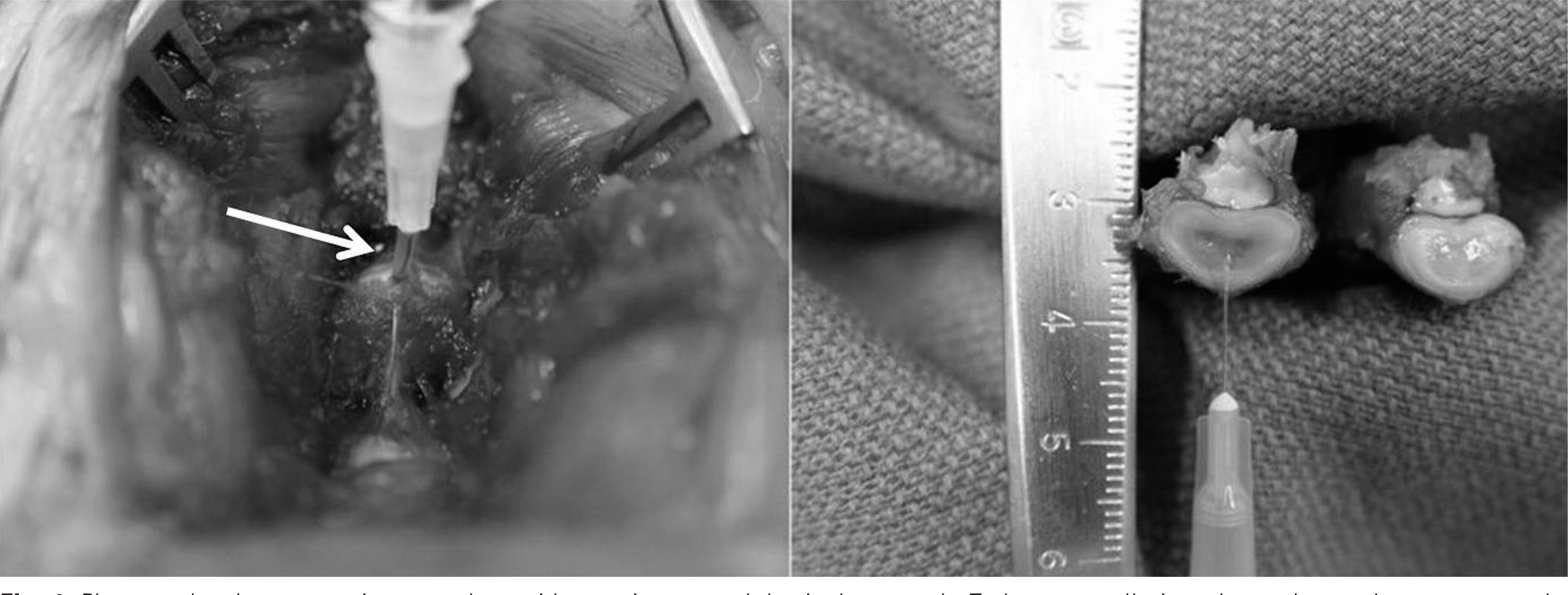
Fig. 2.
Radiological disc height index = (B+C+D)/3M. 4 landmarks were chosen at corners of the vertebral body. Two straight lines (A and E) were drawn using 4 landmarks. Two additional lines (B and D) were drawn by dividing evenly the distance between the first 2 lines and center line(C). M was taken center line of vertebral body.
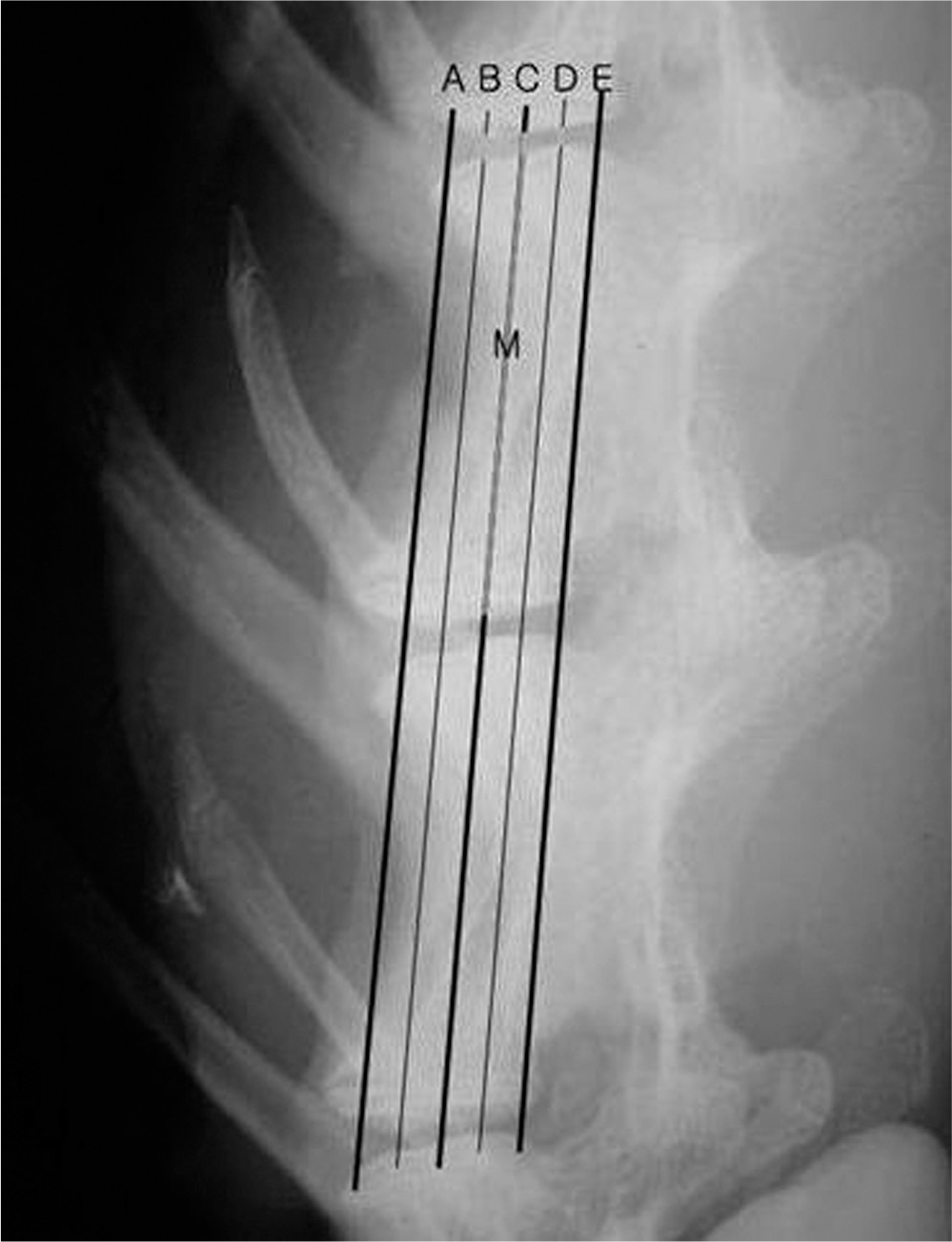
Fig. 3.
Comparison of results from radilological disc height index. There was no difference in the radiological disc height index among the three groups (p=0.194).
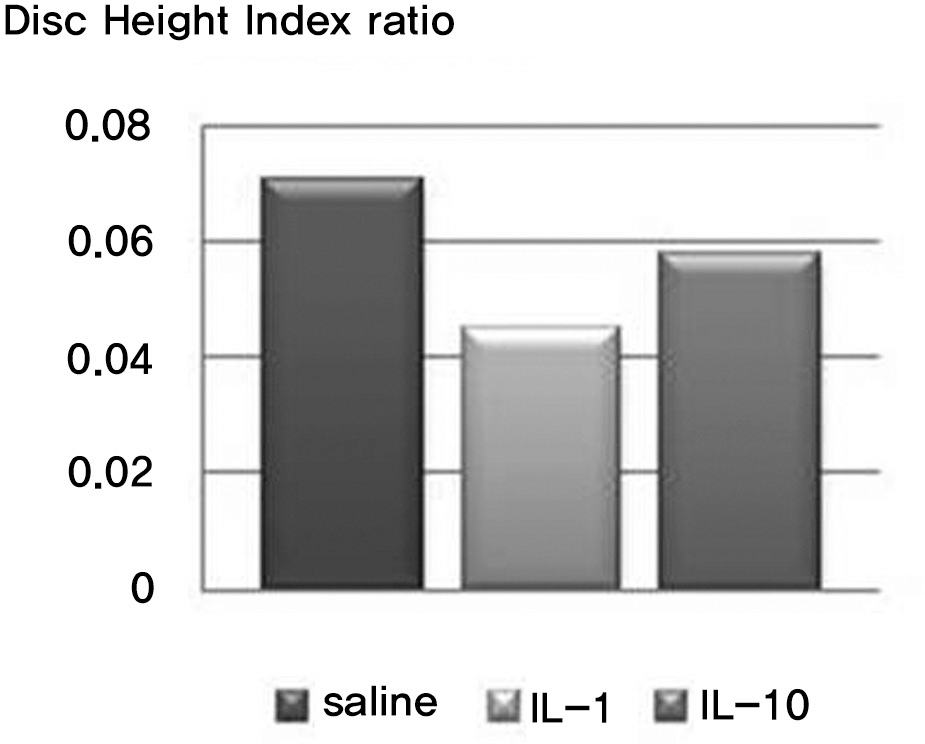
Fig. 4.
Comparison of histological results of cellularity in nucleus pulposus. The histological cellularity of nucleus pulposus revealed decrease of the number of cell (*p=0.0001, **p=0.001).
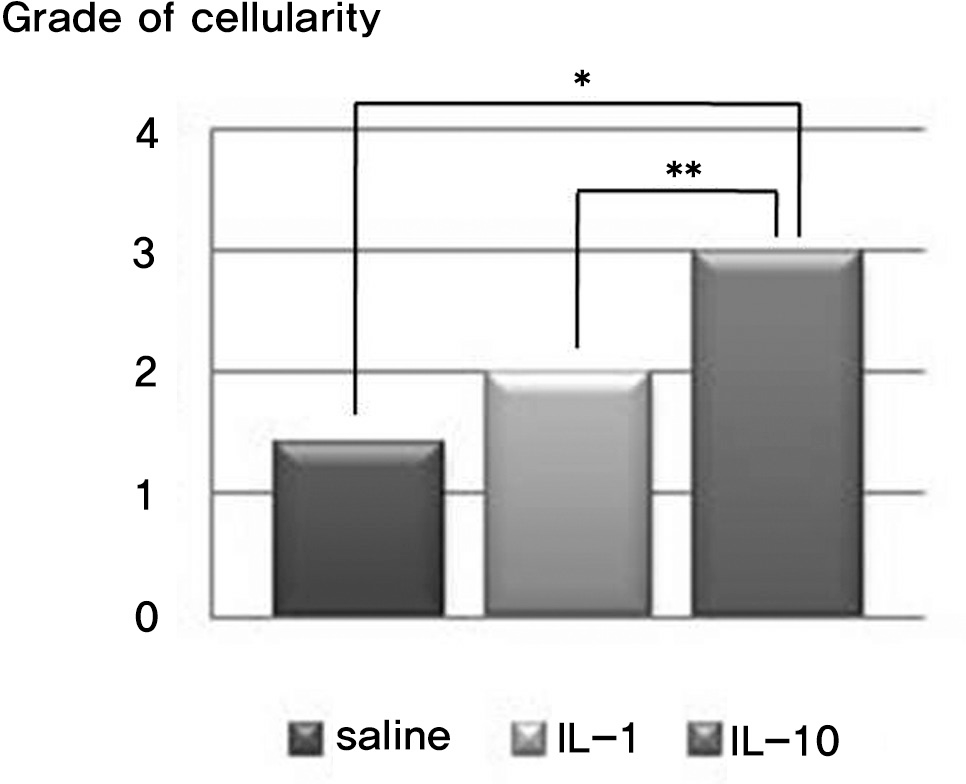
Fig. 5.
Histoloical finding of cellularity in nucleus pulposus revealed normal cellularity with vacuoles in the gelatinous structure in untouched disc(A) and saline (B), slightly decrease in the the number of cells in IL 1μg/ml (C), severe decrease (>50%) in the number of cells in IL 10μg/ml(D) (Stained with toluidine blue, 16X).
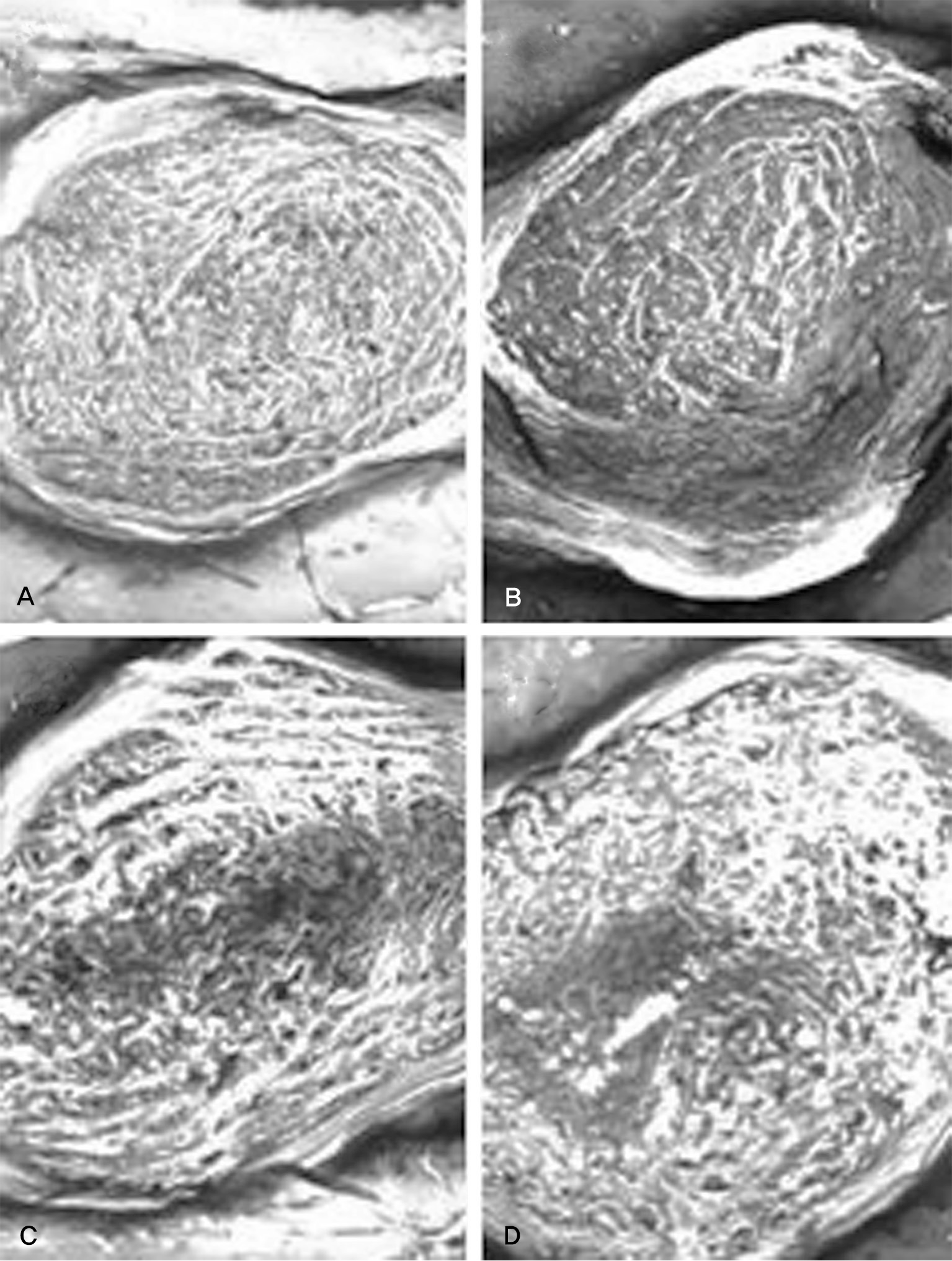




 PDF
PDF ePub
ePub Citation
Citation Print
Print


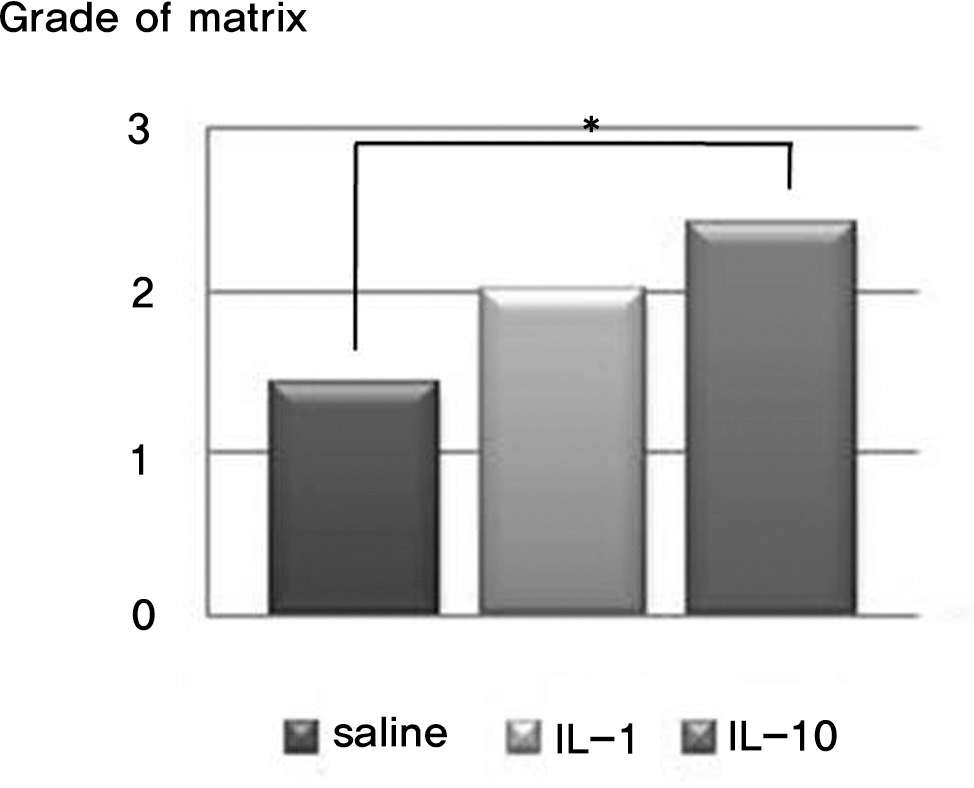
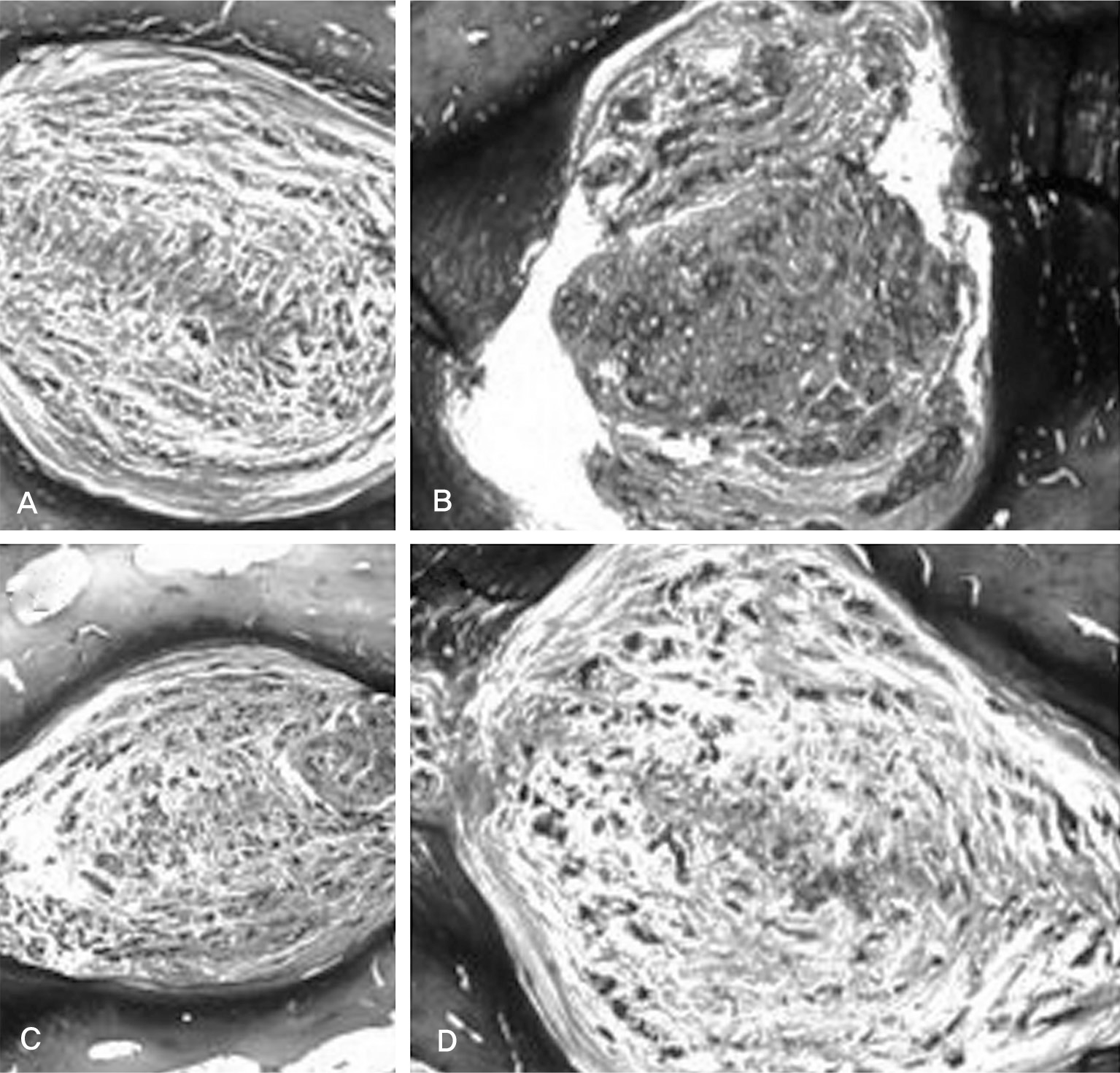
 XML Download
XML Download